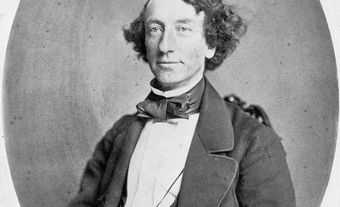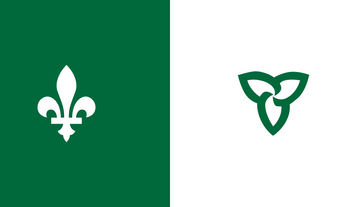The Union Nationale was a Québec political party founded in 1935 and dissolved in 1989. The party won six provincial elections between 1936 and 1966. Maurice Duplessis was its charismatic leader until his death in 1959. The party of a generation, the Union Nationale defended provincial autonomy, conservatism, economic liberalism and rural life.
The Union Nationale was originally a coalition of the Conservative Party and the Action libérale nationale, formed to contest the 1935 provincial election in Québec. The coalition's leaders were Maurice Duplessis of the Conservative Party and Paul Gouin of the ALN. Québec Conservatives viewed their federal counterparts, led by Richard Bedford Bennett, as centralizers and distanced themselves from them. Narrowly defeated in 1935, the Union Nationale became united under Duplessis' leadership and easily won the 1936 election.
Formed during the Great Depression of the 1930s and after 39 years of Liberal government, the Union Nationale initially advocated social, economic and political reform. In 1936, the Union Nationale abandoned the idea of nationalizing hydroelectricity, one of the main planks of the Action libérale nationale platform. The Quebec Liberal Party then defeated the Union Nationale in 1939, after a campaign in which federal Liberals said that they would protect French Canadians from conscription.
Years in Power
Duplessis’s Union Nationale was re-elected in 1944 after accusing both the provincial and the federal Liberals of betraying Québec and violating its rights. The Liberal Party had not opposed conscription and had agreed to constitutional reform that would give the federal government complete control of employment insurance. The Union Nationale received fewer votes (36 per cent) than the Liberal Party (39 per cent) but won an absolute majority of seats in the Legislative Assembly. This nationalist slant became a distinctive characteristic of the party.
The Union Nationale was dominated by Duplessis until his death in September 1959. Paul Sauvé then led the party until his death less than four months later. The defeat of the Union Nationale in the 1960 election under Sauvé’s successor, Antonio Barrette, set the Quiet Revolution in motion. The 1962 general election was called early so that voters could approve the nationalization of hydroelectricity, and the Union Nationale, which opposed the reform, suffered a crushing defeat.The leaders’ debate between Daniel Johnson (Union Nationale) and Jean Lesage (Liberal) was the first ever to be televised in Canada. The Union Nationale was in power one last time between 1966 and 1970. A favourable electoral map and the growth of the two sovereigntist parties helped the Union Nationale to win the majority of seats, although it received fewer votes (41 per cent) than the Liberal Party (47 per cent).
Rapid Decline
The death of leader Daniel Johnson in 1968 was a heavy blow to the party, and in 1970 the Jean-Jacques Bertrand Union Nationale government was defeated by Robert Bourassa’s resurgent Liberal Party. Replaced by the Parti Québécois as the nationalist party, the Union Nationale never won more than 20 per cent of the vote in subsequent elections. The party, then led by Gabriel Loubier, changed its name to Unité Québec in an attempt to break with the past and renew itself. After a bitter defeat in the 1973 election, in which not a single Union Nationale candidate was elected, the party reverted to its original name. Under new leader Rodrigue Biron, the Union Nationale sided with the Yes campaign during the 1980 referendum, which caused the party to crumble and rapidly decline. It won 4 per cent of the vote in 1981 and 1 per cent in 1986 before finally dissolving in 1989.
During the 1940s and 1950s the Union Nationale enjoyed a significant advantage over the Liberal opposition because of its large election chest, built up mostly with contributions from the business sector. However, this changed after the party's defeat in 1960 and the reform of electoral practices in Québec. The repositioning of political parties — especially the formation of the Parti Québecois, and the Liberal Party’s shift to the right — also contributed to the decline of the Union Nationale.
A Changing Platform
The Union Nationale’s platform and policies changed considerably over time. Provincial autonomy, a key theme during the Duplessis era, was not a central issue in the 1936 election campaign because a Conservative government was in power in Ottawa. In fact, the Union Nationale argued for autonomy primarily when a Liberal government was in power federally. The adoption of the Fleurdelisé in 1948, Québec’s official flag with four fleurs-de-lis, was a major symbol of the fight for autonomy (see Provincial and Territorial Emblems).
From an economic and social standpoint, Duplessis’ Union Nationale implemented laissez-faire policies, especially on natural resource development and hydroelectricity. However, his government invested in regional development by focusing on roads and highways, hospitals, schools, and especially rural electrification. Duplessis was frequently accused of patronage because he gave preference to entrepreneurs and businesspeople close to the party for construction work, which was mostly done in Union Nationale ridings.
As for labour relations, many strikes occurred during the Union Nationale’s years in power. Among these were the Asbestos strike (1949) and strikes by Louiseville textile workers (1952–53), Murdochville miners (1957), and Canadian Broadcasting Corporation producers (1959). The government handled these conflicts with a firm hand and relied heavily on the provincial police to counter the strikers. The fight against socialism was another feature of the Duplessis platform, and it found expression in the Act Respecting Communistic Propaganda, which was passed in 1937. Better known as the Padlock Act, this piece of legislation empowered the authorities to close buildings or residences that were being used to propagate Communism or Bolshevism.
Duplessis’ four consecutive terms in office sparked considerable opposition. Cité Libre, an intellectual magazine founded in 1950, provided a mouthpiece for opponents of Duplessis such as Pierre Elliott Trudeau, René Lévesque, Gérard Pelletier and Pierre Vallières. Refus global, a manifesto written by Automatiste artists in 1948, challenged the conservatism of Québec society and its failure to change. The women's movement also challenged the government; a key player was Thérèse Casgrain, who fought for women’s suffrage until 1940 and then led the Social Democratic Party of Québec from 1951 to 1957.
During its final term from 1966 to 1970, the Union Nationale continued reforms undertaken by the Liberal Party during the Quiet Revolution. Under Daniel Johnson, the author of Égalité ou indépendance (1965), the Union Nationale government established CEGEPs (1967), the Université du Québec network (1968), and the Société d’habitation du Québec (Québec Housing Corporation) (1967). It was also under a Union Nationale government that plans for the Québec health insurance plan were drafted (see Health Policy).
The Union Nationale received most of its support from rural voters, small- and medium-scale businessmen, and non-unionized labour. It did not win the trust of English speakers, except in the 1976 election: to the chagrin of many English-speaking Québécois, the Liberal government passed the Official Languages Act (Bill 22) in 1974, so they voted in large numbers for the Union Nationale. Note also that the Union Nationale enjoyed greater success in Québec City than in Montréal. In addition, it was the party of a generation: voters who were in their twenties during the 1930s were its most loyal supporters. The party subsequently struggled to renew its electoral base, which led to its decline.

 Share on Facebook
Share on Facebook Share on X
Share on X Share by Email
Share by Email Share on Google Classroom
Share on Google Classroom




